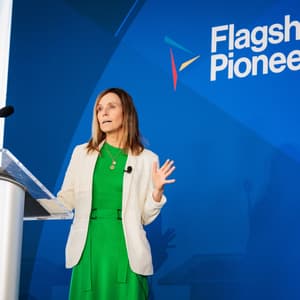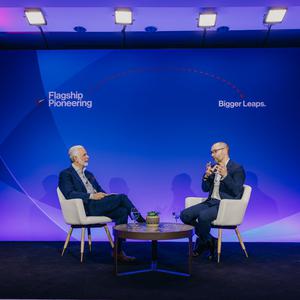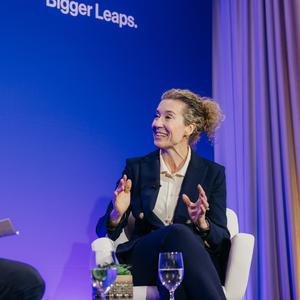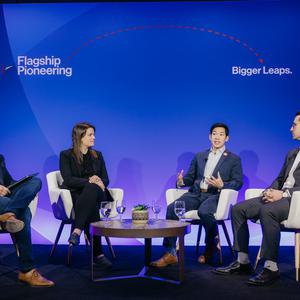Exploration has a beguiling duality. A poem attributed to Sir Francis Drake, the explorer and privateer, captures it well as I think about lessons to guide these tumultuous times even though it was written nearly 450 years ago. The poem’s connection to Flagship can be found here, but the penultimate stanza reads this way:
. . . to dare more boldly,
To venture on wider seas
Where storms will show your mastery;
Where losing sight of land,
We shall find the stars.
The poem captures well an important learning from my life experience as a refugee and immigrant: heading far from shore can lead to discoveries that are almost magical. Uncertainty can equal opportunity.
It also speaks to a distinction I have puzzled over for years in building companies based on pioneering science and have only recently begun to better understand: the distinction between risk (when future events occur with estimable probability - how likely is this ship and crew to survive a storm?) and uncertainty (when the likelihood of future events is incalculable - what are we going to encounter when and if we next reach land?). For those interested in this topic, the original concepts are presented in Frank Knight’s 1921 treatise Risk, Uncertainty and Profit. The differences between risk and uncertainty are powerful, and powerfully important when it comes to scientific endeavor.
Finally, the poem speaks to the connection between challenge and mastery: 2020 and 2021 were in many ways defined by the global storm of COVID19, which I wrote about in last year’s Annual Letter. From diagnostics to treatments to life-saving vaccines, the storm enabled biotech to truly show its mastery.
The worst of the COVID storm passed in 2022, but this persistent, crafty, unyielding virus continues to churn up rolling seas, and its effects still ripple across the globe. Add to that dislocation in capital markets and mixed economic signals; contentious elections, war, and darkening geopolitics; dire predictions about the pace and devastation of climate change – each obscuring fixed landmarks we tend to navigate by to predict what lies ahead.
But is losing sight of land always such a bad thing?
In this letter, I reflect on some of the phenomena shaping scientific exploration in biotechnology, and what they suggest about where the sector is headed. I also aim to make a case for venturing far from shore, and for embracing the opportunities born of uncertainty, even – perhaps especially – in turbulent times.
The Increasingly Navigable Depths of Uncharted Biology
Until quite recently, the navigational tools available to plumb the depths of unexplored biological territory were quite limited. To solve biological problems, we had to engage in guesswork and over-simplification, an expensive and time-consuming proposition with low odds of success.
This is rapidly changing. Thanks to the advances in our ability to generate large amounts of data from both healthy and diseased tissue, combined with artificial intelligence and machine learning capabilities to interpret, learn, and draw insights from that information (more on AI later in this letter), we are now turning biological problems into digital problems, and have the capacity to rationally engineer optimal solutions. Simply put, we can increasingly envision a desired health outcome and program a solution to get there. We believe these approaches will increasingly transform the current probabilistic outcomes into increasingly deterministic ones.
It is no exaggeration to describe this change as revolutionary. We now live in “The Biological Century” with unprecedented capacity to harness biology to benefit both humanity and the world we inhabit. As historian and biographer Walter Isaacson puts it, what microchips were to the last century, molecules are to this century. Armed with powerful new tools, biotech is poised for exponential progress.
To learn more about Flagship companies translating complex “big biology” into new medicines by registering it as data and code, explore Profound Therapeutics and Empress Therapeutics.
AI Is Changing Everything: Augmenting Imagination as Well as Intelligence
If you’ve recently received a stylized photo of your friends or relatives -- the ones where the person is reimagined as Victorian royalty or perhaps someone out of the Avengers -- you’ve probably heard of Lensa AI, the most popular iPhone app in the US as of this writing, or DALL-E, which creates images from language prompts (we used sentiments from this letter to generate the images you see at the top and at the close). Or maybe, and more remarkably, you read about OpenAI’s ChatGPT, which can compose poems, answer scientific questions, suggest new recipes, and write anything from college essays to computer code. Computers harnessing vast amounts of information, “learning” tasks and patterns, and generating novel products was only recently an imagined future. That future is here.
The implications for biology – and biotechnology – are full of potential and uncertainty. AI will transform biology in this century the way bioinformatics transformed it in the last. Advances in machine learning models, computing power, and data availability are enabling a vast universe of previously unaddressed challenges to be tackled and creating opportunities for developing novel proteins and other biomolecules that can mimic any structure and generating de novo molecules that can be designed for therapeutic benefit.
Innovations recently published by our team at Generate Biomedicines demonstrate the capability of these new tools to predict, design, and ultimately generate de novo proteins whose structure and folding patterns are reverse-engineered to code for a desired medicinal function. Machine learning is augmenting not just intelligence but also imagination, inferring the rules of biology that have been too complex for humans alone to derive and conjuring new understanding of biological processes. Understanding biological phenomena better will help us build “digital twins” of biological systems – from cells to tissues to organs.
To learn more about Flagship companies developing AI-enabled medicines, explore Cellarity, Valo and Harbinger Health.
The Biotech Markets Mismatch: Risk vs Uncertainty
The prevailing storm in capital markets has been a challenge to navigate over the past year. Capital markets convulsed with uncertainty over how the economy would transition from a global pandemic and its once-in-a-generation effects. The subsequent downturn clouded the path for emerging biotechs and sank many promising early-stage companies, including some founded by Flagship. However disquieting this storm of uncertainty might be, it is vital to remember that it is unrelated to the opportunity, promise, and value of biotechnology. Recent valuations are not reflective of the exponentially expanding fundamental science, technology, and opportunity in biotech – and its ability to create value for society.
The near-term capital markets picture remains choppy. There is a substantial debate on the probability, timing, and severity of a recession in the US. The majority of economic forecasters are predicting a recession during 2023. Interest rates are expected to continue rising, pressuring growth companies and restricting their ability to enter the public markets. Biotech initial public offerings (IPOs) declined from 74 in 2021 to just 9 in 2022. Mainstream investors have rotated from biotech for now. Roughly 82 percent of 2022 offerings are trading below issue. But this is not a static environment.
Again, the calculus is one of risk vs uncertainty. Yes, the current market conditions carry non-trivial risk, and that risk needs to be actively managed in this sort of storm. At Flagship, that has meant everything from managing burn rates, to increasing our pharma alliances and reducing or redirecting development programs. We have also selectively increased ownership of our public companies through participation in follow-on offerings. The risk for more mature companies is more easily calculated and managed.
But when attempting to measure the value of technologies whose potential for impact is uncertain, risk calculations are less applicable, if applicable at all. Better to focus on the overall climate of opportunity. Storms, like the current market conditions, are temporary. We must navigate through them to find the better weather beyond. Climate drives the patterns that ultimately will impact more people and create more value. In other words, focus on big picture systems versus smaller obstacles in the way. Today’s market challenges have little to do with the staggering ongoing needs in human health and sustainability. The biotech climate has never been more promising: for modifying how disease is treated, how we develop treatments, how we solve some of our world’s biggest challenges.
The 21st century will see accelerating advances in understanding and regulating biology. These biological advances – from pioneering bioplatforms like those at Flagship companies – will have an outsized impact on the globe and its inhabitants as compared with any other sector or endeavor. We envision a world where companies target a desired health outcome and design the intervention to predictably and efficiently achieve it by creating modalities that can be applied across many disease indications leveraging a common technology. We envision a world with ubiquitous precision diagnostics to guide care and treatment. We envision a world where agriculture, food, and sustainability are forever transformed by life sciences to improve the lives of people everywhere.
For companies in the business of breaking boundaries, valuation rarely reflects value potential. Many of the transformational biotechnology companies launched in the last 30 years saw nearly all their value created after 10 years in business. By nature, disruptive platform companies have long-term biases – and valuations can be disconnected from reality due to the short-term bias of capital markets. Truly world-changing innovation carries unknown variables and uncertainties that do not fit readily into standard investor frameworks of near-term risk. At Flagship, we believe this gap is bridgeable by mastering the ability to identify opportunities with great uncertainty and converting them over time to carry risk – as well as upside – that is knowable and manageable.
Emerging biotech still enjoys a very favorable structural environment whereby deep-pocketed larger companies increasingly turn to entrepreneurial biotechs to fill their research and development pipeline. Large biopharma companies have more than $620 billion in cash that could be deployed in deals with private or public biotechs. Recent deals and positive clinical trial data releases have shown how this kind of activity can have a rapid ripple effect throughout the sector.
More broadly, cutting-edge biotech platform technologies are coming of age. Cell and gene therapy, mRNA, protein degraders, multi-specific antibodies, and antibody drug conjugates are traversing from the realm of uncertainty to near certain therapeutic benefit. The past year has done nothing to stop that tectonic shift. The enormous opportunity for value creation in biotech will only improve, no matter what the current market weather.
The strategy behind Flagship and its origination of companies remains steadfastly focused on the future, pioneering science that pushes well beyond adjacencies to solve major human health and sustainability challenges. The more important consideration in evaluating our path forward is the underlying value creation opportunity — and never has there been a greater wellspring of potential for impact.
Several Flagship companies are creating programmable medicines and pioneering delivery approaches: explore Omega Therapeutics, Tessera Therapeutics, Laronde, Alltrna, Ring Therapeutics, and Senda Biosciences to learn more.
Pioneering Science Doesn’t Work. Until It Does.
In December 2022, scientists at Lawrence Livermore National Labs (LLNL) made a stunning announcement: they produced fusion ignition — more energy out from a fusion reaction than was put in. Harnessing fusion, the process that powers the sun, has been elusive to researchers for decades. So this success suddenly opens the door to the potential of a powerful, plentiful source of clean energy.
This achievement was rightfully greeted with global excitement fueled by new optimism over the potential of fusion as a renewable, non-polluting energy source.
The very same day as the LLNL fusion announcement, scientists at Flagship-founded Moderna also announced a big leap forward in their efforts to apply mRNA science to cancer. The biology of cancer has long provided hope that the progression and recurrence of a particular cancer could be prevented through a vaccine-based immunological approach, but decades of clinical trials have shown little benefit over alternatives. That is, until Moderna, in partnership with Merck, displayed the impact of its personalized mRNA cancer vaccine when combined with Merck’s Keytruda. Compared to Keytruda alone, Moderna’s vaccine cut the risk of recurrence or death of one of the deadliest cancers, melanoma, by an additional 44% in a mid-stage trial.
Both of these scientific breakthroughs represent a truth too little understood about making big leaps in scientific progress: Pioneering science doesn’t work . . . until it does.
Flagship-founded Seres Therapeutics is a timely example of this phenomenon. About a decade ago, we asked: What if . . . we could understand and then harness the full power of the microbiome to treat human diseases in the gut? Seres worked backward from that envisioned future, overcoming setbacks and perfecting the science of this new modality. This past October, the biologic license application (BLA) for SER-109 was accepted for priority review by the FDA for the treatment of recurrent C. diff infection, the leading cause of health care-associated infections and an urgent public health crisis. Pending approval in April, SER-109 will be available to meet a critical unmet need and will open a new era for microbial therapeutics.
Against a backdrop of slowing rates of disruption reported in scientific papers and patents, these recent breakthroughs are heartening to scientists in pioneering fields, a community accustomed to perseverance in the face of obstacles. While we can see fusion every day as the sun shines and stars twinkle, replicating it here on earth has taken nearly 100 years of effort riddled with setbacks, uncertainty, and doubt. Even as these same factors continue to swirl while scientists look to harness this potentially limitless source of energy to combat climate change, breakthroughs like this should remind us all of what is possible when we keep our gaze fixed beyond the horizon.
Preemptive Health and Medicine Has Potential to Transform Healthcare
When it comes to clinical innovations that don’t work until they do, 2022 served up big, increasingly scaled breakthroughs in treating diabetes and obesity. Drugs such as tirzepatide and semaglutide treat obesity as a chronic metabolic disease and, in this way, may carry a host of preemptive health benefits: improved blood pressure or cholesterol levels, improved blood sugar levels in patients with diabetes, delayed onset of type 2 diabetes, and reduced risk of heart attacks, strokes, and cardiovascular deaths.
Such novel treatments point to the enormous promise of preemptive health and medicine — and to why Flagship Pioneering is so committed to this burgeoning field, still in its exciting early days.
Take for example Montai Therapeutics, Flagship’s most recently launched company. Montai is pioneering the creation of Anthromolecule™ medicines – derived from a privileged class of molecules with a history of safe, human consumption — to treat and preempt chronic disease. The company platform couples advancements in the digitization of natural chemistry and human biology with powerful computational tools to evaluate millions of bioactive Anthromolecule™ connections to validated disease pathways, and efficiently prioritizing high potential treatments.
To learn more about our Preemptive Health and Medicine portfolio companies, explore Harbinger Health, Apriori Bio, and YourBio Health.
We believe we’ll discover in the years ahead that many of the cellular processes that lead to disease conditions afflicting billions of people around the world can be slowed, delayed, or stopped altogether before disease takes hold. The implications for our longevity (lifespan), our health care spending, and our quality of life (healthspan) are inestimable.
Agriculture, Food, and Climate Solutions Will Be Driven by Biotech Innovation
Earlier in this letter, I mentioned the recent progress in nuclear fusion, a thrilling scientific achievement that should inspire us all. However, its impact on our current climate crisis will be decades in the making. Climate change is an immediate threat that requires swift action with solutions that can be deployed today.
After years of pioneering in everything from biofuels to renewable chemicals, Flagship’s sustainability companies have zeroed in on agricultural and food systems because of their potential to make an immediate and material impact on planetary health. About 40% of landmass is dedicated to growing crops and raising livestock, and approximately 70% of our freshwater supply is used for agriculture. There may be no single industry that affects the health of the planet more.
Flagship has originated many of our sustainability companies by posing questions that are a variation on a theme: What if . . . we can apply what we learn about human health to crops, insects, plants, and trees? It turns out biotech innovations for human health can drive agricultural, food, and climate solutions. To date, four Flagship-founded ag companies support the foundational ambition of the industry — to produce quality calories to feed the planet — while also securing and ideally enhancing our precious resources.
To learn more about Flagship Pioneering companies transforming the global agricultural system explore Indigo Agriculture, Inari Agriculture, CIBO Technologies, and Invaio Sciences.
One example: Gene editing technologies that were previously only applied to human health are being extended to advance crop sciences by Flagship-founded Inari. The company is designing better seeds for the world’s largest crops that produce higher yields with less water and chemical fertilizer. Plants that can achieve the same or greater yields with less nitrogen can make big strides in decarbonizing agriculture.
Biotechnology is still largely associated with solving pressing challenges in human health; that is rapidly changing. Our health and the health of the planet are intrinsically linked. Prolonging human health and longevity won’t matter without a healthy planet to call home.
Pushing Back the Horizon
As I think about the voyages into uncertainty that lie ahead for all of us as the year unfolds, you might be surprised to learn that I think the most critical capacities for success are neither instrumental nor even tangible. We believe that in navigating uncertainty, the most important tools for surviving and thriving are imagination, hope, faith, and courage.
There is a George Bernard Shaw quote I love that speaks to the power of imagination: “Imagination is the beginning of creation. You imagine what you desire, you will what you imagine, and at last you create what you will.”
While Shaw’s three stages more likely reference creating literature or theatrical works than pioneering science or company creation, I suspect most entrepreneurs would confirm the central role of imagination in sparking their journey to build something with no precedent.
Hope is perhaps less explored in this regard, but the higher the degree of uncertainty in any endeavor, the more vital it is to be fueled by a sense of possibility. Hope fuels the ingenuity and effort needed to convert the imagined into the realized.
Flagship’s strategy for value creation under extreme uncertainty is resilient, adaptive, and tested across many cycles and in many forms. We are in an age of exploration when bioplatforms can change the world and improve lives. Navigating uncharted waters suddenly makes those waters charted, navigable, and valuable. Risk profiles are a function of familiarity. Embedding artificial intelligence and machine learning into bioplatforms has the power to bring the future to the present even faster.
But to be clear, harnessing biology still carries a great degree of uncertainty, and leaders will succeed in our sector by pushing beyond the boundaries of what we once thought was possible or imaginable. It is in that space beyond boundaries where big leaps forward are possible, where new solutions are unlocked.
Horizons are, after all, optical illusions: from a distance they suggest an end point, but when you move toward and beyond them, they move too. Nearly 450 years ago, Sir Francis Drake understood this. His poem – the one that opens this letter – ends with lines akin to an explorer’s creed, and a call to action:
We ask You to push back
The horizons of our hopes;
And to push into the future
In strength, courage, hope, and love.
I can think of no better ingredients for creating enormous value for years to come, through change and through storm. With the right leaders to guide our explorations, and our crew of fellow explorers, the courage and conviction to withstand difficult conditions, and with imagination, hope, and faith, we can nurture and nudge the impossible toward the possible. From there, the possible becomes repeatable, scalable, valuable, and world changing. Let’s embrace this time of biological possibility and change the future in ways that expand the horizons of hope for all of us.
See you on the seas.
Noubar Afeyan, Ph.D.
Founder & CEO, Flagship Pioneering








